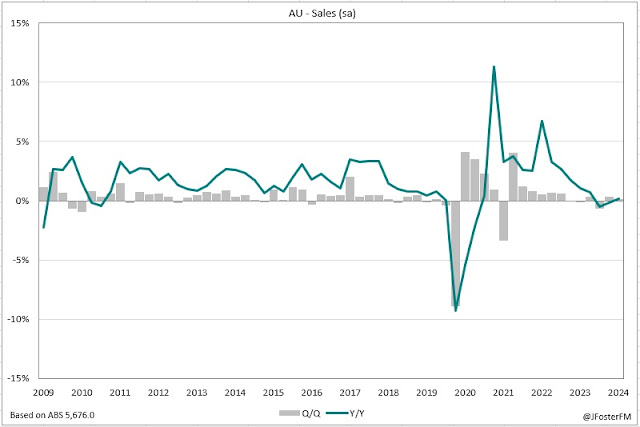Australia's business indicators series for the September quarter was weak across the key details of inventories, sales, and company profits. Domestic demand remains subdued weighed by cost-of-living pressures and higher interest rates. Soft demand, falling commodity prices and margin pressures are impacting company profits. Private non-farm inventories look to have cut 0.5ppt from GDP growth in the quarter, a downside surprise.
Sales volumes lifted by just 0.2% in the September quarter after falling by 0.3% across the first half of the year. Demand in the consumer-facing sectors of retail (0%) and hospitality (-0.4%) is is weak; however, arts and recreation was up strongly (3.3%) - suggesting that households are still able to spend but are doing so more selectively.
Declines in sales were notable in professional services (-1%) and manufacturing (-0.8%), while utilities also fell (-1.3%) - likely reflecting the impact of government subsidies on electricity bills. On a more positive note, construction advanced (1%) indicating supply and cost pressures could be easing, while a pick-up in mining (1.2%) should support exports (details due tomorrow). Telecommunications (1.3%) was also an area of strength.
Inventories declined more sharply than expected contracting by 0.9% for the quarter (vs -0.1% forecast). Some of this can be attributed to the mining sector (-2%) as shipments to overseas markets rebounded, which will add to growth; but falls in retail trade (-1.4%) and hospitality (-4.4%) are consistent with demand weakness - potentially firms are turning to discounting to clear inventory overhangs. Overall, declining inventories are estimated to deduct 0.5ppt from GDP growth in Q3, with further details from the public sector due tomorrow.
A range of headwinds is impacting company profits, which fell by 4.6% in the latest quarter to be down 8.5% through the year. On an inventory-adjusted basis (closer to the methodology used in the National Accounts), company profits contracted 3.9% quarter-on-quarter (-8.2%Y/Y).
The driving factor behind declining profits is falling commodity prices, directly hitting the mining sector (-8.8%q/q, -16%Y/Y); however, non-mining profits are also under strain (-1.7%q/q, -2.8%Y/Y) from margin compression amid weak demand and input cost pressures.
Growth in the wages bill lifted by 1.2% in the September quarter - its strongest quarter-on-quarter rise in a year - supported by robust employment growth and the 3.75% rise to award rates determined by the Fair Work Commission coming into effect. Annual growth, however, continues to slow, stepping down to 4% from a 5.4% pace through the year to Q2.






